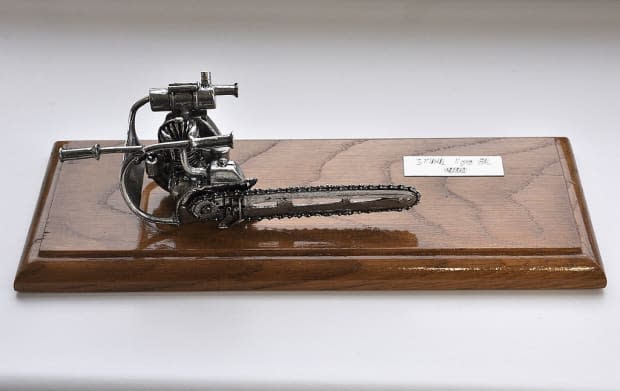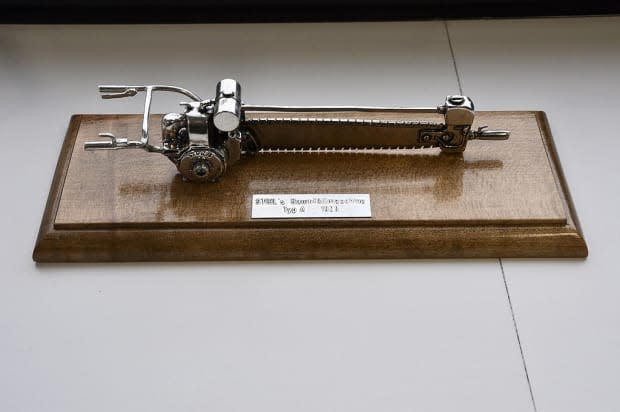Why Were Chainsaws Invented? Let's Cut to the Chase—The Answer May Leave You a Little Queasy
Thank goodness for modern medicine—that's all we have to say.
History is filled with plenty of shocking reminders about the great strides we've made in invention and technology. And sometimes, you even hear about an invention that began with a purpose that has little to do with its usage today. For example: Why were chainsaws invented? Well, the answer is a bit of a doozy.
Looking back at the origin of the chainsaw, mixed emotions erupt (maybe even a little vomit too) as I think about the horrific reason this device came to fruition.
What if I told you that the chainsaw was designed for medical procedures? You may be thinking, “What? That can't be right,” or, “Oh, it can't be that bad (can it?).”
But before you start thinking that developing a device like a chainsaw to perform medical procedures isn’t that bad, read further to find out exactly what procedure we are talking about.
What Was the Chainsaw Invented For?
Prepare yourself for this news: The chainsaw was originally invented for childbirth, as well as the excision (or "cutting out") of bone.
Now, just imagine—at the time the chainsaw was prototyped in the 18th century by two Scottish doctors, John Aitken and James Jeffray, there were no anesthetics. No numbing medicines. No sleeping for the patient so they won't remember the pain.
The teeth of the chainsaw-like device known as a “flexible saw” were thought to be able to cut through the human bone at a fast rate, resulting in small wounds that would heal quickly. The two Scottish Physicians designed a “chainsaw” that had a fine-toothed link chain that cut on the concave side around 1783-1785. By 1803, the two had successfully used the device to remove diseased bones of the knee and elbow of patients. Although the saw was, in fact, used in child birthing, it was never more than "conceptually" popular with most obstetricians—the majority decided that the use of the device would cause too many complications and shied away from its use. However, for much of the 19th century, the chainsaw was a useful surgical instrument.
Related: Why Were Teddy Bears Invented? We Won’t Toy With You—Find Out if the Viral Rumors Are True
What Was the Chainsaw Originally Called?
The chainsaw prototype was called a “flexible saw” until it was redeveloped in 1830 by a German doctor named Bernhard Heine, who specialized as a bone specialist. He originally called it an osteotome. (Osteotome’s root word “ost” means “bone.”)
The flexible saw became powered by a hand crank (which still sounds pretty gruesome when thinking about medical procedures), but a serrated chain was looped around a guiding blade, allowing for a smooth rotation. The doctor could easily hold the contraption more like a knife—increasing precision.
Related: What Does 'SOS' Mean? Surprisingly, It's Likely Not What You Think

Manfred Schmid/Getty Images
What Did the First Chainsaw Look Like?
The first chainsaws were manufactured using gold-plated parts and tortoise shell handles. They were used when performing procedures like a symphysiotomy, which involved cutting cartilage and ligaments in order to get a breach, or difficult-to-deliver baby, out of the mother.

Manfred Schmid/Getty Images
Eventually, the chainsaw was redesigned, leaving the physician world and entering the blue-collar setting, when it got another facelift.
The new look and new use of the chainsaw were evident as it looked more rugged, was extremely heavy (coming in at a hefty 120 lbs.) and took two people to operate.

iStock
Becoming the chainsaws we recognize today
In 1905, the first electric chainsaw was patented by Samuel Bens, who designed them to cut down the giant redwoods in California. As the 20th century developed, so too did better chainsaw designs—from the hefty and cumbersome model of Bens’ to what we recognize today as a powerful (cordless) handheld tool.
Because the original patent expired, the ingenuity race was on for the development of chainsaws and was led by a German company originally named Festo. Andreas Stihl made huge strides in chainsaws developing the electric chainsaw for logging sites in 1926 & gas-powered saws in 1929. Festo eventually became the well-renowned Stihl company we know today.
The history of the chainsaw is one of those unusual cases where an invention cascades from being a medical device (one of which is hard to imagine being used without anesthesia!) to a can't-live-without tool used in modern-day society and would be considered a modern marvel.

